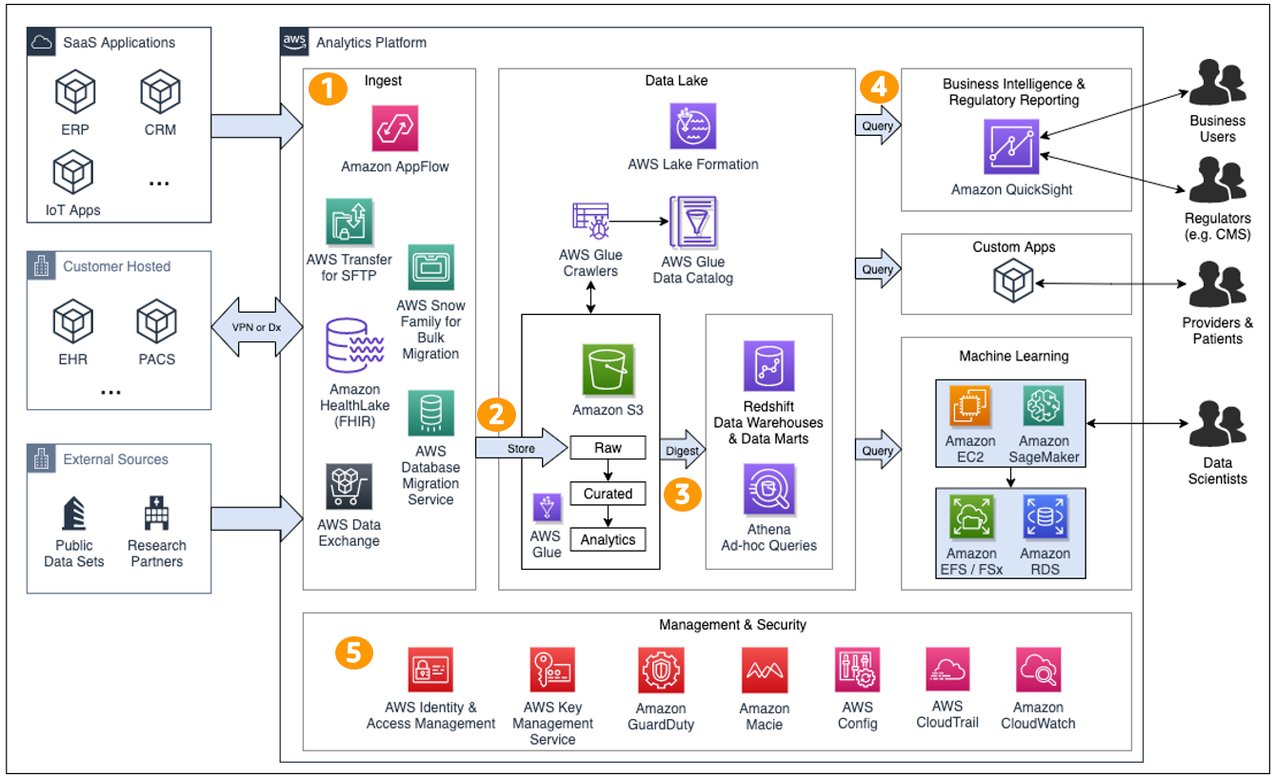Healthcare analytics reference architecture
This section covers a reference implementation of a healthcare
analytics platform using native AWS services. Refer to
the Architecture
Best Practices for Analytics and Big Data

A representative healthcare analytics environment.
-
The analytics platform must support the wide variety of communication protocols used by healthcare systems including bulk data feeds and real-time data streams. Examples include bulk data transfers using secure FTP, HL7v2 over MLLP and standard FHIR web services. Legacy protocols that don’t support encryption must run over an encrypted channel such as a Site-to-Site VPN.
-
Store raw data in a durable, highly available, and secure object store such as Amazon S3. Enable default encryption to verify that all objects are encrypted at rest. Lifecycle policies can be set up to reduce costs based on your access requirements. Many AWS and third party services provide direct integrations with Amazon S3 for data integration and backup. AWS Lake Formation provides a framework to organize and secure the data within the Amazon S3 data lake.
-
For high volume message ingestion, batch messages through services such as Amazon Kinesis to reduce the number of actions taken to store the data. This can reduce the overall cost of data ingestion. Prevent data integrity issues by ensuring the batching process aligns with the requirements of the data pipeline.
-
Use AWS Glue Crawlers to automatically discover and catalog schemas for the raw datasets. AWS Glue ETL processing workflows transform and normalize the data through serverless and horizontally scalable jobs. Track data lineage to establish traceability and reproducibility for compliance. Use Amazon Redshift for data warehousing and Amazon Athena for SQL queries against cataloged datasets.
-
End users interact with the data and insights across all the normalized healthcare data through a number of ways. For example:
-
Business users and regulators perform analysis, view dashboards, and receive reports using business intelligence tools like QuickSight.
-
Custom application integrations use the data to surface insights to end users, including to the point of care. Data can be accessed using a variety of AWS services such as Lambda functions, containers running in Amazon ECS, Amazon EKS, or AWS AppSync. Verify that the AWS services being used are eligible for the healthcare compliance framework applicable to your workload (such as the HIPAA Eligible AWS Services
). -
Machine learning (ML) experts can pull standardized datasets and combine them with datasets using custom data preparation processes.
-
-
Use IAM and Lake Formation to narrowly scope permissions. Access controls should be enforced across all AWS environments. Use Amazon CloudWatch to monitor your solution's metrics, logs, and alarms. Use AWS CloudTrail to monitor access to AWS APIs along with GuardDuty to alert on unusual activity. Use Amazon Simple Notification Service (SNS) for sending notifications to on-call engineers and other data consumers. Amazon Macie can automatically discover and categorize sensitive data such as personally identifiable information (PII) and protected health information (PHI). An audit log must be used to capture all sensitive data access (create, read, update, and delete) for regulatory compliance purposes.